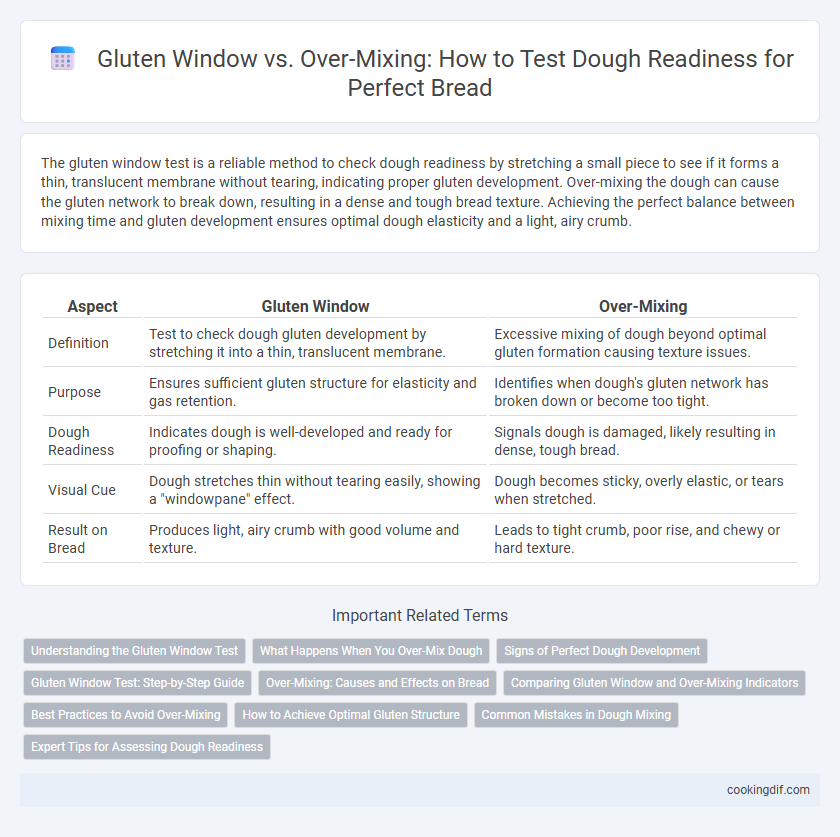The gluten window test is a reliable method to check dough readiness by stretching a small piece to see if it forms a thin, translucent membrane without tearing, indicating proper gluten development. Over-mixing the dough can cause the gluten network to break down, resulting in a dense and tough bread texture. Achieving the perfect balance between mixing time and gluten development ensures optimal dough elasticity and a light, airy crumb.
Table of Comparison
| Aspect | Gluten Window | Over-Mixing |
|---|---|---|
| Definition | Test to check dough gluten development by stretching it into a thin, translucent membrane. | Excessive mixing of dough beyond optimal gluten formation causing texture issues. |
| Purpose | Ensures sufficient gluten structure for elasticity and gas retention. | Identifies when dough's gluten network has broken down or become too tight. |
| Dough Readiness | Indicates dough is well-developed and ready for proofing or shaping. | Signals dough is damaged, likely resulting in dense, tough bread. |
| Visual Cue | Dough stretches thin without tearing easily, showing a "windowpane" effect. | Dough becomes sticky, overly elastic, or tears when stretched. |
| Result on Bread | Produces light, airy crumb with good volume and texture. | Leads to tight crumb, poor rise, and chewy or hard texture. |
Understanding the Gluten Window Test
The gluten window test evaluates dough elasticity by gently stretching a small piece to check for smooth, translucent thinness without tearing, indicating proper gluten development. Over-mixing dough causes the gluten strands to weaken and break down, resulting in a dough that tears easily during the gluten window test. Mastering the gluten window technique helps bakers determine optimal dough readiness and avoid the negative effects of over-mixing on bread texture.
What Happens When You Over-Mix Dough
Over-mixing dough causes the gluten network to become too tight and dense, resulting in a tough, chewy texture rather than a light and airy crumb. The gluten window test shows dough elasticity and extensibility, but overworked dough fails this test by tearing easily and losing stretch. Excessive mixing also introduces excess heat, which can impair yeast activity and lead to poor rise and dense bread.
Signs of Perfect Dough Development
The signs of perfect dough development include a smooth, elastic texture and a well-formed gluten window that stretches thin without tearing, indicating optimal gluten network formation. Over-mixing results in a dough that is too tight, resistant to stretching, and prone to tearing, signaling that the gluten strands are excessively developed or broken down. Achieving the ideal gluten window confirms the dough is ready for proofing, ensuring a light, airy crumb in the final bread.
Gluten Window Test: Step-by-Step Guide
The gluten window test involves stretching a small piece of dough between your fingers to check for a thin, translucent membrane without tearing, indicating proper gluten development. Achieving this stage confirms the dough is well-kneaded and elastic enough for baking, avoiding the pitfalls of over-mixing that can break down gluten structures and result in a dense loaf. This simple tactile test offers a more reliable measure of dough readiness compared to timing or visual cues alone.
Over-Mixing: Causes and Effects on Bread
Over-mixing dough causes excessive gluten development, resulting in a tough and overly elastic texture that negatively impacts bread volume and crumb structure. This process breaks down the gluten network, leading to dense, heavy bread with poor oven spring. Proper dough handling ensures a delicate balance between gluten formation and dough extensibility to achieve optimal bread quality.
Comparing Gluten Window and Over-Mixing Indicators
The gluten window test reveals dough readiness by showing a thin, translucent membrane without tearing, indicating proper gluten development. Over-mixing dough results in a tight, rubbery texture that breaks easily during the gluten window test, signaling excessive gluten breakdown. Comparing these indicators helps bakers achieve optimal dough elasticity and structure, essential for high-quality bread.
Best Practices to Avoid Over-Mixing
Achieving the perfect gluten window is essential for optimal dough elasticity and structure, preventing over-mixing which can lead to a dense, tough loaf. Best practices include gentle folding techniques and frequent dough rest periods to allow gluten development without excessive agitation. Monitoring the dough's stretchability and elasticity helps bakers determine readiness while avoiding over-working the dough, ensuring a light, airy bread crumb.
How to Achieve Optimal Gluten Structure
Achieving optimal gluten structure requires developing a strong gluten window without over-mixing the dough, which can weaken the gluten strands. The gluten window test involves gently stretching a small piece of dough until it becomes thin and translucent without tearing, indicating proper gluten development. Maintaining a balance between sufficient kneading time and avoiding over-mixing ensures dough elasticity and strength for perfect bread texture.
Common Mistakes in Dough Mixing
Creating the perfect gluten window is essential for achieving optimal dough elasticity and structure, while over-mixing can break down gluten strands, resulting in a dense and tough bread texture. Common mistakes include either under-kneading, which leads to insufficient gluten development, or excessive mixing that damages the dough's network, both compromising the final loaf's rise and crumb. Understanding the balance between adequate gluten formation and avoiding over-mixing is crucial for consistent, high-quality bread baking results.
Expert Tips for Assessing Dough Readiness
Assess dough readiness by performing the gluten window test, where a small piece of dough is gently stretched to check for a thin, translucent membrane without tearing, indicating proper gluten development. Avoid over-mixing, which breaks down gluten strands and results in a dough that tears easily and lacks structure. Experienced bakers balance mixing time and gluten window results to achieve optimal dough elasticity and strength for perfect bread texture.
Gluten Window vs Over-Mixing for dough readiness Infographic

 cookingdif.com
cookingdif.com